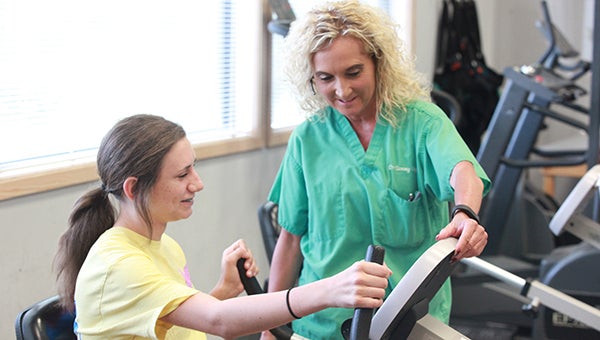Good Samaritan valuable resource
Published 9:37 am Wednesday, September 16, 2015

- REHABILITATION FITNESS: Tammy English, owner of Good Samaritan Physical Therapy Clinic, helps a patient with motion in her legs during her rehab session.
Tammy English isn’t a fan of bureaucracy. That’s why she opened a clinic of her own.
English has been practicing physical therapy for 30 years. She received her education from Mississippi State, the University of Mississippi Medical Center and Boston University.
English is also certified to teach vestibular rehab and how to determine if someone has vertigo and how to treat it.
English is the sole owner of Good Samaritan Physical Therapy and has been since its founding in 1996. She started seeing home health patients and only had a few therapists working with her.
She started her clinic to get away from the bureaucracy of hospitals and work with patients who need help.
“You can’t do that as something you don’t own because you don’t have that decision making power,” English said. “Lets say you don’t and have insurance but want to work out a payment plan, you don’t get that at a big entity.”
Good Samaritan is a comprehensive outpatient rehab facility, which is different from a single physical therapy practice. They provide treatment for backs, necks and orthopedic problems like knees and rotator cuffs.
English has a lot of highly trained therapists in different areas at her clinic. They do physical therapy, occupational therapy and pediatric services.
“We are in a sense the biomechanical experts of the medical field,” English said. “We in a sense are finding the root of the problem. There’s just about no diagnosis we haven’t seen here.”
Sometimes English will request respiratory therapy. Since there isn’t a full-time respiratory therapist on staff, English will contract a respiratory therapist and make them apart of a patient’s physical therapy.
“Let’s say your grandmother has a history of asthma or chronic obstructive pulmonary disease. During the winter months a lot of these problems flare up and patients have difficulty breathing. We bring them in, check their oxygen and work with the physicians closely,” English said.
English will recommend to the respiratory therapist the patient might need portable oxygen, put them on an exercise program and might give a breathing treatment before therapy starts. Good Samaritan also has easy access to doctors on site if they were to ever get into a medical bind.
Being a comprehensive outpatient rehab facility, English said they are able to provide a little bit better care for the patients.
“Our therapists are really well trained in how to recognize the signs and symptoms of patients as they’re exercising. Whether they had a stroke or a knee replacement,” English said.
In the case of a stroke patient, an occupational therapist will work with a patient to help dress themselves again and move in-and-out of a bathing area. A physical therapist will work with walking and gross motor skills. A speech therapist will work with swallowing and articulation.
“Your occupational and your speech therapist a lot of times will work with them to work on cognitive training, working with them on sequencing,” English said. “Like making a peanut butter and jelly sandwich. When you have a stroke sometimes it affects that part of the brain.”
English said Good Samaritan isn’t about laying a patient on a mat, lifting their leg up 30 times and saying, “hey, you’re good to go.”
“We want to return that person back to their ‘maximum level of function,’ so that they can return back to whatever they did before and enjoy life,” English said. “It’s all about maximizing that functional potential.”
More News





